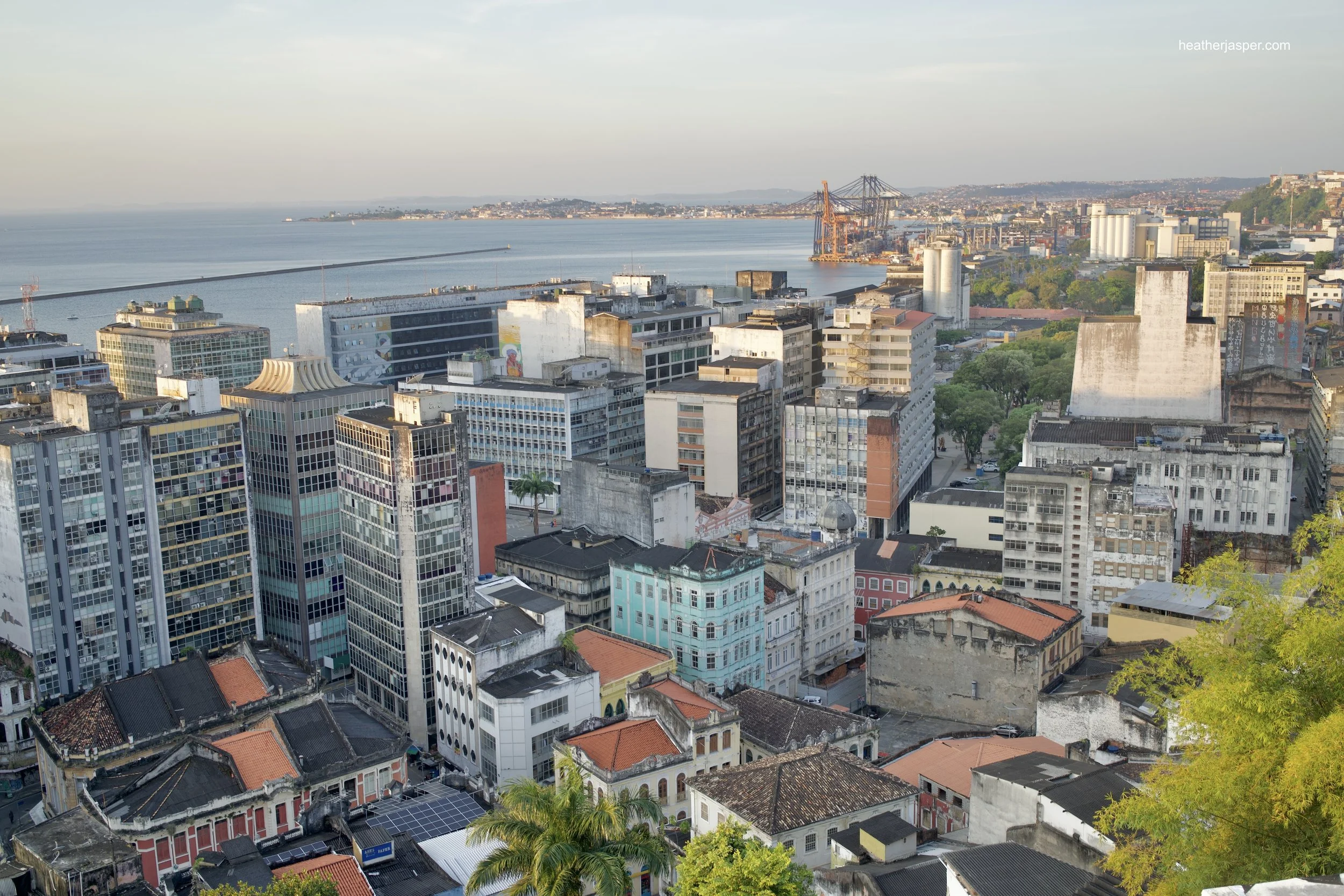Salvador da Bahia
Plaza at the top of the Lacerda Elevator that connects the Pelourinho and Comercio neighborhoods.
This coastal city of almost 3 million people is full of colorful history and culture. I loved everything about it: the food, the music, the beaches, and even the museums. Salvador is a giant sprawl of different neighborhoods, each with its own name and feel. Most neighborhoods are either very rich or very poor, with a few falling somewhere in the middle. Still, most of the city is economically and racially divided.
I stayed in Barra (above), a modern and upscale part of the city within walking distance of the Praia da Pedra Alta beach. (Read more about Salvador’s beaches here).
I visited Brazil in October, which is both the low season for tourism and the time of year with the lowest temperatures. I’m a hot weather wimp and am grateful that my friends told me to come in October. It was plenty hot during my time in Salvador and around the state of Bahia, so I don’t really want to know what it’s like the rest of the year. Regardless of the temperatures, I didn’t find big crowds of tourists anywhere during my month in Brazil.
Coastal Salvador Old and New
The old forts and lighthouses on the coast are both historic tourist attractions and functioning lighthouses still needed by cruise and cargo ships coming to the port.
The rocky coastline, as dangerous as it may be for ships, is fabulous for swimmers as the rocks break the waves and leave the beaches calm and safe.
The most touristy part of town is Pelourinho, which you can read about on this blog. Check out the Pelourinho blog for foods like acarajé and musical performances like the Balé Folclorico da Bahia.
Cidade da Música da Bahia
I’m not usually a big museum fan, but Salvador’s museums are fun and interactive. I especially loved Cidade da Música da Bahia. This is Tárcis Rocha, museum docent, in a museum workshop on percussion instruments. Follow him on Instagram @tarcisrochapro
The Cidade da Música da Bahia is just what the name says it is, more than a museum, it’s a whole city of music. I spent four hours there but could just as easily spent eight and still not seen or heard everything.
It is the most interactive and modern museum I’ve seen anywhere in the world. It opened in 2021 and all the exhibits are designed to be directed by the visitor with their smartphone. It would be difficult to visit without a phone. I would guess that only half the museum would be as interesting if you didn’t have a phone with which to interact with the exhibits.
Igreja da Bomfim
Salvador has 365 churches. Some Catholic saints have more than one church each. Igreja da Bomfim is the most important church on the south side of the city.
Saint Francis’ Day in Itapuã
For the patron saint of animals, the Igreja São Francisco de Assis in Salvador’s Itapuã neighborhood holds a special service for people to bring animals to be blessed. Most people brought dogs when I was there but there was one 55-year-old tortoise that caught the news crew’s attention.
Candomblé
As important as Catholicism in Salvador is the religion of Candomblé. It grew out of a syncretism of the religions of people brought from Africa and sold as slaves. Many of the objects needed for Candomblé practices are sold here at the Feira São Joaquim.
Comercio
This lower part of the city, near the port, is called Comercio. The cliffs above are the Pelourinho neighborhood.
Salvador is a very large city, and I found the best way to get around was with Uber. The rideshare service is cheaper than taxis and locals consider it safer since you get information about the driver before you get in the car.
Bikes in Salvador
Like most big cities these days, Salvador has a system of rental bikes, which are great along the coast. Most of the city is a series of hills and I never saw people on orange bikes far from the beach.
Every blog I see about Brazil addresses safety.
I felt safe everywhere I went in Salvador, whether alone or with friends. However, I also got information from my Salvadorian friends about the relative safety of different parts of the city. Sometimes they told me not to take my camera with me. Sometimes they just told me to not take the camera out of my bag if I was in the street. I never saw any theft or crimes my four weeks in Brazil, though I was constantly reminded by my friends where and when I could go alone safely.











